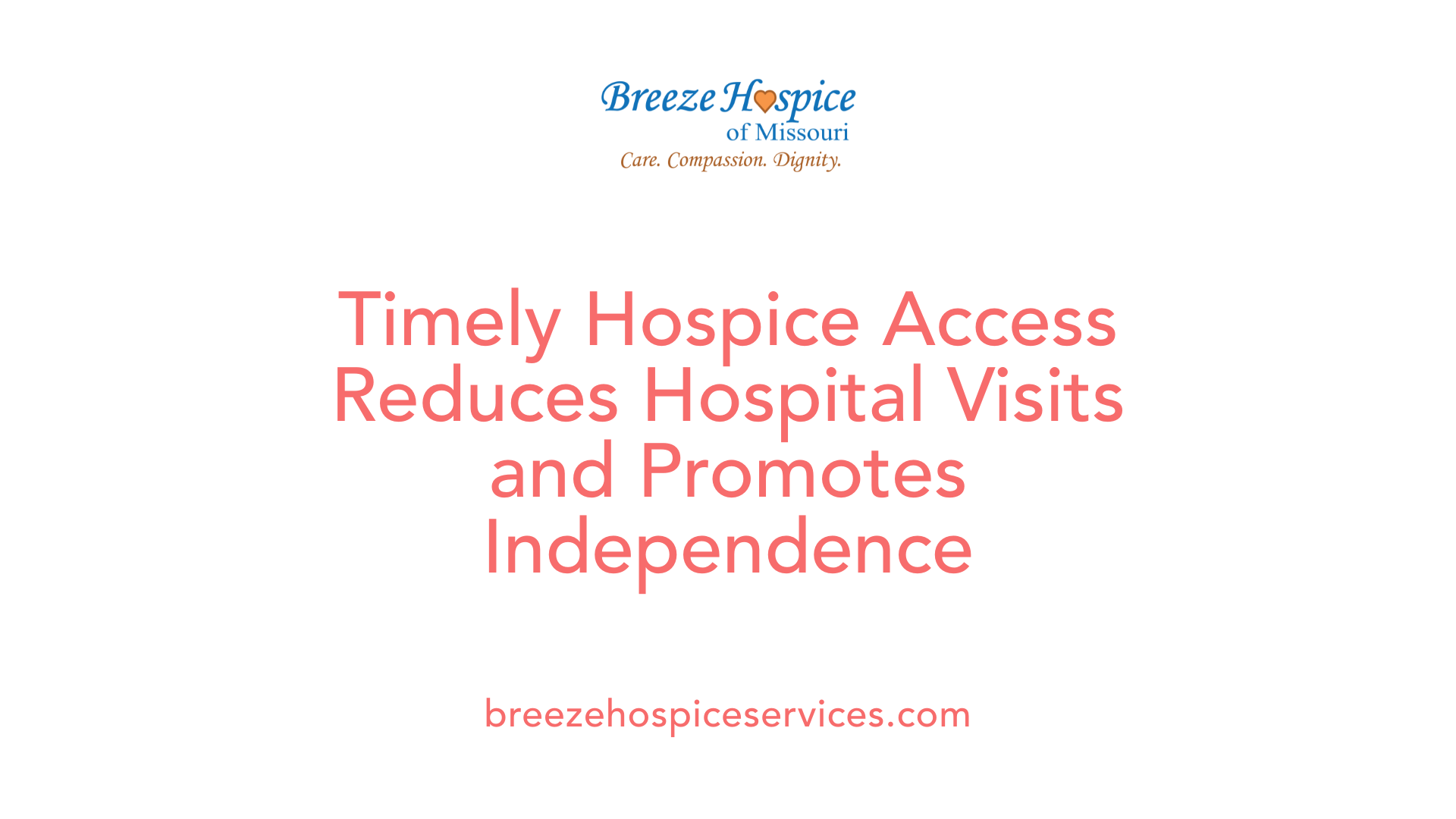Advantages of Early Hospice Referral
April 25, 2025
Understanding the Critical Benefits of Initiating Hospice Care Early

An Overview of Early Hospice Intervention
Early hospice referral offers a multitude of benefits that significantly enhance patient outcomes, improve quality of life, and provide vital support to families and caregivers. Recognizing the signs and understanding best practices for timely referral can lead to more compassionate, effective, and cost-efficient end-of-life care. This article explores the advantages of early hospice integration, emphasizing evidence-based practices and the positive impact on all involved parties.
Enhanced Patient Outcomes and Symptom Management

What benefits does early hospice referral provide for patient outcomes?
Early referral to hospice care significantly improves multiple aspects of a patient’s health and well-being. One of the most notable advantages is the enhanced management of symptoms such as pain, nausea, and psychological distress, which often become more difficult to control in advanced stages of illness. By initiating hospice services earlier, patients benefit from timely, coordinated symptom relief strategies that are tailored to their individual needs.
Hospice care is not solely focused on comfort but also on supporting patients in maintaining as much independence as possible. It provides an interdisciplinary approach that includes medical management, emotional support, spiritual counseling, and social services. This comprehensive care helps patients remain in familiar settings, primarily their homes, which many find comforting during their final months.
Reduced hospitalizations and emergency room visits are among the critical outcomes associated with early referral. Since symptoms are closely monitored and managed proactively, patients are less likely to experience crises that necessitate urgent hospital care. This continuous, holistic approach not only benefits patients but also alleviates strain on healthcare resources.
Research indicates that patients enrolled in hospice earlier tend to live longer compared to those who are referred later in their illness trajectory. The additional time enables patients to participate more fully in meaningful activities, make important decisions about their care, and strengthen relationships with loved ones.
Furthermore, early hospice involvement leads to higher satisfaction levels among patients and families, who often report feeling more supported emotionally and spiritually. This overall improved experience contributes to better mental health and a more dignified end-of-life process.
In summary, early referral to hospice care results in better symptom control, supports management of complex conditions such as cancer, COPD, and dementia, reduces unnecessary hospital encounters, and can extend both the quality and quantity of life. These benefits underscore the importance of timely recognition and initiation of hospice services for patients facing life-limiting illnesses.
The Impact on Quality of Life and Emotional Well-being

How does early hospice referral impact quality of life and symptom management?
Referring patients to hospice care early in their illness journey has a profound effect on their overall well-being. It allows for proactive management of physical symptoms like pain, nausea, and breathing difficulties, which can significantly improve comfort. When symptoms are addressed promptly through hospice services, patients often experience a better quality of life, including less distress and greater ease in daily activities.
Beyond physical relief, early hospice enrollment also supports emotional and psychological health. Patients facing serious illnesses frequently experience anxiety, depression, and fears about death. Hospice teams include mental health professionals who provide counseling, helping patients and families navigate complex emotions and prepare mentally for the end-of-life phase.
Furthermore, early hospice referral creates space for meaningful conversations about values, goals, and wishes, facilitating advanced care planning. This ensures that care aligns with what matters most to the patient, bolstering a sense of control and dignity.
Research consistently shows that patients who start hospice services earlier tend to have longer stays, often live more peacefully, and have fewer emergency hospitalizations near the end of life. They also are less likely to pursue aggressive treatments that may not improve quality of life. As a result, early hospice engagement enhances not only physical comfort but also emotional and spiritual peace, leading to a more compassionate and personalized end-of-life experience.
Support for Families and Caregivers
The benefits of early hospice care extend beyond patients to their loved ones. Families gain time to understand the disease process, discuss concerns, and develop coping strategies. Caregivers receive education on managing symptoms, medication administration, and emotional support, which can reduce stress and burnout.
Spiritual support is an integral component, offering patients and families solace, meaning, and a sense of spiritual well-being. Chaplains and spiritual counselors help individuals process spiritual questions and find peace during this difficult time.
Overall, early hospice referral fosters a supportive environment where families feel more prepared, informed, and emotionally connected, making the journey less traumatic and more meaningful for everyone involved.
Improved Care Planning and Patient Autonomy

How does early hospice referral facilitate care planning and decision-making?
Early referral to hospice plays a crucial role in empowering patients and their families to participate actively in end-of-life care planning. When patients are introduced to hospice services sooner, they, along with healthcare providers, can engage in meaningful conversations about their wishes, preferences, and goals for quality of life.
This early engagement allows for the development of personalized, comprehensive care plans tailored to each individual’s needs and values. It includes discussions about symptom management, pain control, emotional and spiritual support, and preferred place of care, typically at home or another familiar setting.
Advance directives and decision-making assistance are integral parts of early hospice planning. Patients have the time to complete healthcare directives, specify their treatment preferences, and appoint healthcare proxies. These documents help ensure that their wishes are respected, even if they become unable to communicate later.
Additionally, early involvement in care decisions encourages more informed choices about treatments, interventions, and hospice services. It helps clarify expectations and prepares patients and families for the progression of illness, reducing uncertainty and anxiety.
Accurately identifying the right timing for referral is facilitated by clinical indicators such as a declining Palliative Performance Scale (PPS) score of 70% or less, worsening symptoms, frequent hospitalizations, and other signs of disease progression. Using these markers ensures that patients receive the right level of support when it is most beneficial.
Overall, timely hospice referral ensures patients receive appropriate, respectful, and dignified care aligned with their values, significantly improving quality of life while reducing unnecessary hospitalizations and emergency visits.
Financial and Systemic Advantages of Early Initiation

Are there cost benefits associated with early hospice referral?
Yes, early hospice referral offers notable cost savings for healthcare systems. When patients enter hospice care sooner, there is a marked reduction in hospital admissions, emergency room visits, and length of inpatient stays. These decreases not only improve patient comfort and quality of life but also significantly lower healthcare expenses.
Structured referral strategies that include timely social needs assessments and palliative care consultations—often within three days of admission—amplify these savings. Early intervention prevents unnecessary procedures and avoids complications that often lead to costly hospitalizations.
Advances in care coordination further optimize resource utilization. For example, integrating eConsults and referral tracking software ensures timely and appropriate hospice referrals, reducing redundancy and improving communication among care teams.
Research supports these practices: models incorporating early hospice engagement demonstrate double-digit reductions in overall healthcare costs. These include lower Medicare expenditures, fewer emergency interventions, and less utilization of intensive inpatient resources.
Efficient resource allocation is also facilitated through better planning and anticipatory management. When care teams identify high-risk patients early, they can develop personalized, holistic care plans, which prevent crisis interventions and associated costs.
Furthermore, insurance programs such as Medicare and Medicaid benefit financially from early hospice incorporation. The overall medical expenditure declines because patients receive focused symptom management and end-of-life care aimed at comfort rather than costly emergency measures.
Impact on Medicare and insurance costs
Medicare, which often bears the largest share of end-of-life care expenses, reports significant savings related to early hospice use. Studies indicate that beneficiaries enrolled early in hospice incur 6 times lower costs in the last three months of life compared to those who receive late or no hospice care.
Hospice services coverage includes medications, durable medical equipment, skilled nursing, and social support, all of which contribute to cost-saving by reducing hospital stays and invasive procedures.
Modern care models incorporating early referral protocols help Medicare avoid unnecessary expenditures associated with prolonged hospitalizations and intensive treatments, translating into more sustainable healthcare spending.
Efficient resource allocation and care coordination
Early hospice referrals foster better coordination between outpatient teams, specialty providers, and hospice care staff. This coordination ensures timely provision of services, medication management, and emotional support.
By addressing these needs early, healthcare providers can better allocate resources, prevent care fragmentation, and reduce the burden on emergency services.
Spreading awareness and implementing standardized care pathways contribute to more efficient use of healthcare resources, ultimately promoting both cost efficiency and improved patient experiences.
| Aspect | Impact | Explanation |
|---|---|---|
| Cost savings for healthcare systems | Significant reductions in overall expenses | Includes fewer hospital stays, emergency visits, and unnecessary procedures |
| Reduction in hospital and emergency services utilization | Lower hospital admission rates | Leads to more in-home and outpatient management, easing system strain |
| Impact on Medicare and insurance costs | Decreased end-of-life expenditures | Facilitated by early engagement, better symptom control, and resource management |
| Efficient resource allocation and care coordination | Improved planning and service delivery | Enhances communication, prevents duplication, and ensures timely care provision |
Ultimately, initiating hospice care earlier not only benefits patients and families but also supports the sustainability of healthcare resources by reducing unnecessary costs and enhancing care efficiency.
Indicators, Guidelines, and Best Practices
What are the indicators and guidelines to determine when a patient should be referred early to hospice?
Deciding the optimal time for hospice referral is crucial for maximizing patient comfort and support. Healthcare providers utilize various clinical indicators and assessment tools to identify when a patient is approaching end-of-life needs.
One of the primary signs for early hospice consideration is a declining performance status. For example, a Palliative Performance Scale (PPS) score of 70% or less often suggests that the patient’s functional capacity is significantly diminished, signaling the need for additional support and symptom management.
Other physical indicators that suggest a declining health trajectory include unintentional weight loss, development of pressure ulcers (stage 3-4), frequent hospitalizations, and recurrent infections. These signs reflect disease progression and increasing burdens of symptoms.
Specific symptoms vary based on underlying conditions. For instance, in chronic obstructive pulmonary disease (COPD), severe shortness of breath and frequent exacerbations indicate worsening status. Liver disease may present with refractory ascites, while dementia patients might experience recurrent infections or worsening cognition.
Assessment tools such as the Karnofsky Performance Status and the Functional Assessment Staging Tool (FAST) assist clinicians in evaluating how well patients are functioning and how rapidly their condition is deteriorating.
Guidelines recommend initiating hospice discussions when patients reach clinical milestones suggesting limited life expectancy—generally less than six months. These include not only physical decline but also psychosocial factors like increased dependency or emotional distress.
Early referral is advantageous because it allows comprehensive management of symptoms—such as pain, nausea, and breathlessness—and provides psychosocial and spiritual support, ultimately enhancing quality of life.
Regular assessments of disease progression, functional decline, and social circumstances should guide timely hospice planning. Interdisciplinary communication is essential to recognize subtle changes that indicate it’s time to consider hospice options.
In summary, clinicians should continually monitor clinical signs and utilize standardized evaluation scales to identify when patients are approaching end-of-life, ensuring that hospice care can be effectively integrated early to support patients and their families during this critical period.
Maximizing Benefits Through Early Enrollment
In conclusion, early hospice referral is a vital component of comprehensive end-of-life care that offers significant advantages for patients, families, and healthcare systems. By initiating hospice services early, healthcare providers can ensure better symptom management, enhance quality of life, promote emotional and spiritual well-being, and foster informed, patient-centered decision-making. Furthermore, early referral contributes to substantial cost savings, more efficient resource utilization, and aligns care with patient preferences and values. Overcoming barriers to timely hospice engagement requires ongoing education, systematic screening, and proactive communication. Ultimately, embracing early hospice referral maximizes the benefits of compassionate, holistic care at life's final chapters, leading to more dignified and fulfilling end-of-life experiences.
References
- Benefits Of Early Referral To Hospice | Services
- Early Intervention Can Help Patients Benefit from Hospice Care at ...
- The Case for Timely Referral to Hospice - VITAS Healthcare
- Benefits of Early Referral - Trustbridge Hospice Care
- Early referral to hospice means better quality of life
- Comfort Can't Wait: Why Starting Hospice Earlier Matters
- Pilot study proves impact of earlier hospice referrals
- 10 Benefits of Early Hospice Enrollment
- Making Hospice Referrals Sooner



































































































